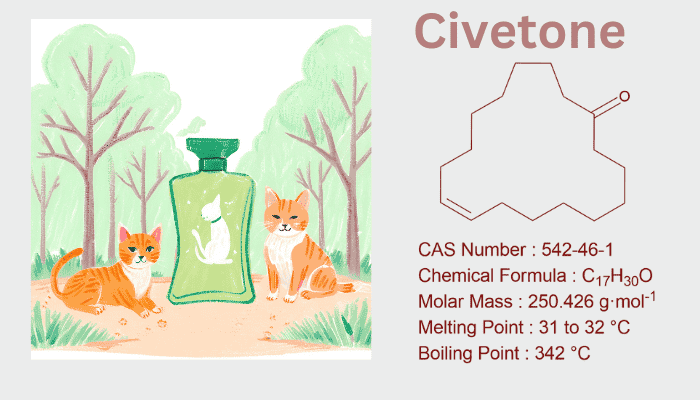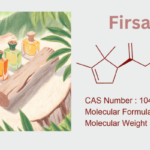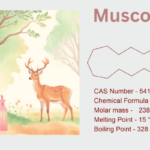1. Introduction: The Enigmatic Allure of Civetone
For decades, chemists and perfumers have been enthralled with ceterone, a chemical that is associated with the primordial charm of animalic scents. This macrocyclic ketone, which was originally extracted from civet cat secretions, was once the pinnacle of luxury and sensuality in perfumery. But because of ethical considerations and developments in synthetic chemistry, Civetone has become a symbol of innovation that unites the precision of the lab with the unadulterated beauty of nature. It continues to be a mainstay of amber and oriental accords today, adding depth, warmth, and an incomparable richness to contemporary scents. This page explains the chemistry, uses, and lasting legacy of ceterone as it travels from jungle glands to gas chromatographs.
2. Chemical Identity: The Molecular Essence of Civetone
Civetone (C₁₇H₃₀O) is a macrocyclic ketone distinguished by:
- A 17-membered carbon ring with a single ketone (-C=O) functional group.
- Low volatility: Boiling point of ~342°C, classifying it as a base note in perfumes.
- Isomerism: exists in the cis isomer in nature, although trans or racemic combinations with mild olfactory differences are frequently produced using synthetic techniques.
Its olfactory power—a single molecule that may evoke musky warmth, leathery richness, and a faint touch of fecal undertones that paradoxically heighten its allure—belies its structural simplicity.
3. Natural Sources: The Civet Cat and Ethical Evolution
Historical Extraction
- Source: Secretions from the perineal glands of the African civet cat (Civettictis civetta).
- Process: Hand scraped from civets kept in captivity, diluted with alcohol, then aged to a gentle abrasiveness.
- Yield: A single gland produces ~3–4 grams of paste, containing ~1% Civetone.
Ethical and Practical Shifts
- Animal Welfare: Natural civet was outlawed nationwide and subject to CITES regulations as a result of criticism of cruel cultivation methods.
- Sustainability: Natural civet’s rarity (and cost: ~$500/gram) accelerated synthetic alternatives.
Modern Perception: While genuine civet was once utilized in historical scents like Chanel No. 5, modern formulations only employ synthetic civetone.
4. Synthesis: From Animalic Secretions to Laboratory Precision
I. Ruzicka Cyclization (Historical Method)
- Precursor: 17-Ketoheptadecanoic acid, derived from animal fats or plant oils.
- Process: The macrocyclic ring is created via high-temperature cyclization with metal catalysts (such as ThO₂).
- Limitations: Low yields (~20%) and reliance on costly precursors.
II. Modern Olefin Metathesis
- Catalyst: Grubbs catalyst facilitates carbon-carbon bond rearrangement.
- Precursor: α,ω-Dienes (e.g., 1,17-diene) cyclized into Civetone’s 17-membered ring.
- Advantages: lower environmental impact, scalability, and higher yields (~70%).
III. Biotechnological Innovations
- Engineered Yeast: Civetone is produced from fatty acids by Saccharomyces cerevisiae treated with cytochrome P450 enzymes.
- Green Chemistry: Solvent-free processes and renewable feedstocks align with EU REACH standards.
Purification
- Distillation: Fractional distillation under vacuum isolates Civetone from linear byproducts.
- Crystallization: Ethanol recrystallization achieves >99% purity for perfumery use.
5. Uses: The Olfactory Powerhouse
Perfumery
- Base Note: Contains amber, chypre, and oriental scents (e.g., Yves Saint Laurent Opium, Gucci Guilty Absolute).
- Fixative: Slows evaporation of volatile top notes (citrus, herbs) and enhances longevity.
- Accord Blending: balances the smokiness of leather, the sweetness of vanilla, and the powderiness of iris.
Cosmetics
- Skincare: Trace amounts add sensuality to unisex lotions and oils.
- Soaps and Candles: Despite difficulties with alkaline stability, it adds dimension to useful items.
Beyond Fragrance
- Flavoring: FDA-approved for trace levels of flavor enhancers (e.g., meat analogs).
- Pheromone Research: Studied for its structural similarity to mammalian signaling molecules.
6. Perfume Formulation: Mastering the Animalic Note
Role in Fragrance Architecture
- Oriental Blends: Combines with vanilla, labdanum, and benzoin for opulent warmth.
- Leather Accords: Mimics the smoky richness of suede with safranal and birch tar.
- Fougières: Softens herbal sharpness (lavender, oakmoss) with creamy undertones.
Iconic Applications
- Historic: Guerlain’s Jicky (1889) was the first synthetic Civetone, bridging the gap between traditional and contemporary scent.
- Contemporary: Tom Ford Tuscan Leather uses Civetone to evoke luxury and raw sensuality.
Formulation Challenges
- Potency: Overuse risks overwhelming compositions (e.g., “barnyard” off-notes).
- Oxidation: Degrades into civetic acid, altering scent profiles. Solutions include:
- Antioxidants: BHT (butylated hydroxytoluene) or vitamin E.
- Encapsulation: Lipid nanoparticles for controlled release.
7. Percentage in Perfume: Balancing Impact and Safety
Civetone’s intensity demands meticulous dosing:
- Fine Fragrances: 0.01–0.1% (e.g., 0.05% in Dior Fahrenheit).
- Eau de Toilette: <0.03% to maintain subtlety.
- Functional Products: <0.001% in detergents for a lingering clean scent.
Regulatory Landscape:
- IFRA: No strict limits, but self-regulation keeps usage low due to sensitization risks.
- EU Allergen Labeling: Requires disclosure if concentration exceeds 0.01%.
8. Challenges and Innovations
Ethical and Environmental Concerns
- Synthetic Dominance: Eliminates reliance on animal-derived ingredients.
- Waste Reduction: Olefin metathesis byproducts repurposed as plasticizers.
Market Trends
- Clean Beauty Movement: Despite the fact that synthetic Civetone is naturally vegan, companies such as Clean Reserve promote “animalic-free” substitutes.
- Niche Perfumery: In their small-batch productions (such as Zoologist Civet), artisans showcase Civetone’s heritage.
Future Directions
- AI-Driven Formulation: Algorithms optimize Civetone blends for hyper-personalized scents.
- Biodegradable Carriers: Starch-based microspheres enhance performance in eco-friendly perfumes.
9. Conclusion: The Enduring Legacy of Civetone
The transformation of ceterone from a contentious animalic note to a synthetic wonder highlights the dynamic interaction between innovation and ethics in perfumery. Its molecular essence continues to inspire, providing perfumers with a tool of unmatched depth and diversity, even though its natural provenance is a thing of the past. Civetone is proof of chemistry’s capacity to maintain nature’s charm without sacrificing quality as the industry moves toward sustainability and transparency. “The soul of a perfume is a great base note,” as perfumer Sophia Grojsman once said. Civetone’s ethereal beauty guarantees that the soul will never be forgotten.










